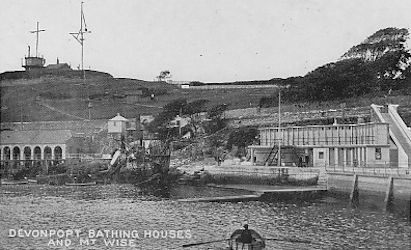|
OLD DEVONPORT
. UK |
||
|
© Brian
Moseley, Plymouth Webpage created: March 27, 2016 Webpage updated: March 20, 2020 |
||
|
THE ROYAL NAVY IN OLD DEVONPORT ADMIRALTY SIGNAL STATIONS
The Admiralty Signal Station at Mount Wise,
Devonport. A series of 32 semaphore signalling stations was installed by the Admiralty between London and Plymouth Dock in about 1810. Within Devon, these were at Haldon, Knighton, Marley, Lee and Saltram. The last station in the chain was at Plymouth Dock and was added to a Redoubt that had been constructed on the site of Mount Wise House in 1778-79. It was used to pass Admiralty signals on to ships moored in the Sound and the Hamoaze. On Friday July 8th 1842 the Port Admiral, Admiral David Milne, based aboard HMS "Caledonia" in the Hamoaze, issued instructions for signals to be used at Mount Wise Signal Station in the event of a fire breaking out at any of the Government establishments in Devonport. By both day and night the first intimation was by a gun being fired, which during the day time would be accompanied by Compass signal at the Flag Staff. At night, if the fire was in the Royal Dockyard, or the Gun Wharf, or anywhere to the westward of Mount Wise, a rocket would then be fired. Alternatively if the fire was in the Royal Marine Barracks, or at the Royal William Victualling Yard, or the Royal Naval Hospital, or anywhere in the Town, then blue lights would be exhibited. During foggy weather the gun was to be fired every four minutes until it was acknowledged by the Flag Ship. The instructions continued: 'The moment the alarm is made from Mount Wise every Ship under my orders is to hoist out her Engine with the proper hoses and fire buckets, and other apparatus which may be considered necessary, such as hooks, ropes, axes, etc. The Engines to have slings and Hoses always attached to it, and the above mentioned articles kept in readiness near the engine. A Commissioned Officer and a proper number of other Officers and men always to be in readiness in any alarm, and when the boat leaves the ship, they are to take in tow the boat which has the engine on board and proceed to the spot where the fire has commenced. The officer of the Flag Ship to take command until superseded by a superior officer or until he receive other orders from the Dock-yard, or through the Commander-in-chief or his Flag Lieutenant.' This was replaced by the electric telegraph in October 1852. However, the old signalling method seems to have continued for in the Naval and Military Record dated June 7th 1888 it was recorded that: 'The Breakwater Fort and the signal station at Mount Wise are to be fitted with 3 arm semaphores at a cost of £84 and £143 respectively'. The new signal station stood thirty feet above the original level and was visible fully a mile beyond the Breakwater. It had semaphore flash lights and that modern invention, the telephone. The Naval & Military Record states that it was brought into use on Friday November 2nd 1888. On Monday June 3rd 1889 the Western Daily Mercury newspaper reported that: 'To-day the four pensioned naval signalmen selected by the Naval Commander in Chief (Admiral Sir W Dowell KCB), for the new signal station erected on the Plymouth Breakwater Fort commence duty. A look-out house has been erected on the top of the fort, together with a steel semaphore, and the house is in direct communication with the chief signal station at Mount Wise and Admiralty House. Two of the men will be on duty both night and day, but definite arrangements as to the exact number of hours they will be kept on and at what period they will be ashore have yet to be arranged. Accommodation for cooking and sleeping has with the full concurrence of the War Office been provided for the men in one of the casements of the fort nearest the look-out house and semaphore.' Chief Signalman J Lawrance was in charge of the Admiralty Signal Station at Mount Wise in 1914. On Saturday July 22nd 1933 the Western Morning News revealed that the Admiralty had given instructions for the time-ball signals at Devonport, Sheerness and Portland to be discontinued and the apparatus dismantled. Until a few years before a gun hand been fired from Mount Wise at 1pm daily at the same time as the time-ball was dropped. The actual date that this would be effective was to be announced. A similar announcement appeared in the Royal United Services Institute Journal in November 1933.
|
||
